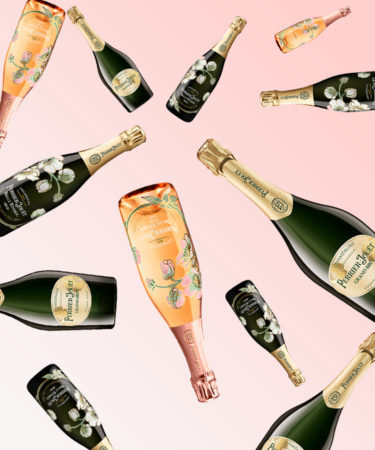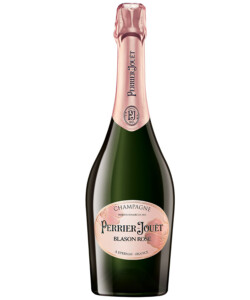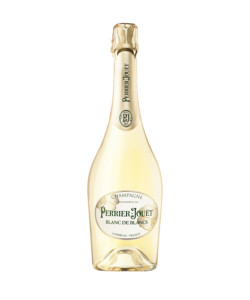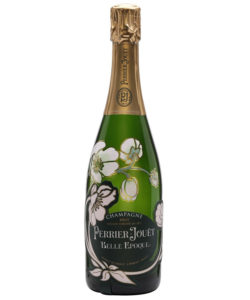If you’ve had the privilege of sipping Perrier-Jouët Champagne, or even if you haven’t, you’ll probably recognize it. The bottle’s famous floral design is beloved among royals and Instagram users alike, the subject of photos by Champagne pros in Paris, socially distanced partygoers in Miami, and this London wine lover’s breakfast. But Perrier-Jouët is known for much more than its impressive looks.
Influential in the world of bubbly for more than two centuries, Perrier-Jouët was among the first Champagne houses to regularly stamp its cork with the date of a blend, also known as its vintage. It also associated quality with season and terroir before “minerality” was cool; and just a few decades into production — we’re talking the 1830s here — the house decided to drastically reduce the residual sugar in its wines, essentially setting the stage for the dry Champagne we drink today.
Here’s a dozen more things you should know about Perrier-Jouët.
-
We’re all pronouncing it wrong.
Unless you’re the one person at the party who knows how to say Moët & Chandon, you probably also didn’t know that you’re supposed to pronounce the “et” part of Jouët. Those two dots mean everything you learned about trailing off at the end of French words ending in “et” was wrong. Per this very helpful video from Social Vignerons, it’s pronounced “Pair-e-yay Zjhooooo-ET” (you don’t have to overemphasize the “et,” but we like people to know so they can learn, too).
-
Perrier-Jouët started with a wedding.
When couples tie the knot, they often celebrate with a Champagne toast. Nicolas Perrier and Rose Adelaide Jouët did that, too, just with a lot more of it. The couple, who founded the Champagne brand, both had prior ties to the wine industry. After getting hitched, they extended their partnership to the Perrier- Jouët Champagne house in 1811, a year after they were married.
-
Perrier-Jouët popularized the ‘brut’ style.
Prior to the mid-19th century, most Champagne was on the sweet side. This is because of the “dosage,” or added sugar, used to restart fermentation in-bottle all for the purpose of creating those vital, life-affirming bubbles Champagne is known for. In those days, dosage was on the higher side, leaving a significant amount of residual sugar.
Then came Perrier-Jouët Cuvée K, a Champagne dosed with a mere 5 percent sugar. It launched in 1846 and was exported to London. The result was a hit. By 1876, the term “brut Champagne” was popularized. Nothing in bubbly has been the same since.
-
Perrier-Jouët has near-perfect vineyards.
Like all Champagne, Perrier- Jouët lives and dies by its terroir. The Champagne house acquired two incredibly important parcels of land for its Chardonnay production in the mid-19th century: the Bourons Leroy and Bourons du Midi. Both are almost pure chalk, which ups the delicacy and minerality of the Chardonnay grapes used in the blend, not to mention is blossomy floral notes.
The original husband-and-wife team was inspired by the winemaking possibilities of the Cramant and Avize regions within Epernay, and this chalky terroir went on to define the Perrier-Jouët style.
-
We can thank Perrier-Jouët for vintage, too.
When Charles Perrier took over for his parents in 1854, he managed the family business pretty well. He also helped alter the way Champagne is consumed and understood by emphasizing the vintage, or crop year, from bottle to bottle. Not only did that become a marketing tool, it connects Champagne to the seasons and (most vitally) the terroir, which is why the Champagne region is a proud, if confusing, patchwork of vineyards where yearly climate, soil, and winemaking impacts are carefully monitored and manipulated to create the most sublime vintage possible.
In a way, Perrier brought Champagne to another level of complexity it might have completely missed out on, as vintage ties Champagne to winemaking and time.
-
Perrier-Jouët ‘Belle Epoque’ symbolizes luxury for all (or all who have $100 lying around).
That one very recognizable Perrier-Jouët bottle? It has a name: Belle Epoque. The term is French for “The Beautiful Age,” a period in French history from 1870 to 1914 during which industrial and cultural flourishing took place. That said, the “beauty” of the age was largely relegated to upper-echelon society. La Belle Epoque symbolized whimsey, excess, and, according to this article, “the very rich’s inability to deal with the grim reality of modern life” — in other words, industrialization.
But today, Belle Epoque isn’t limited to the detached upper class. It’s not chump change, either: A bottle retails for $100 to $130.
-
Its basic blend is grand.
Perrier-Jouët Grand Brut is the flagship style of the house, and a bottle will typically run you about $45. The blend is made with the traditional trio of Champagne grapes: Chardonnay, Pinot Noir, and Pinot Meunier. While the latter two are red-skinned grapes, Chardonnay, a white grape, makes up about 20 percent of the Grand Brut blend. This is vital to the Perrier-Jouët flavor profile. The house’s grapes are highly prized for their high-chalk terroir, which many believe responsible for the telltale floral, delicate Chardonnay flavor.
-
Perrier-Jouët’s most famous bottle was lost for more than half a century.
After artist Emile Gallé came up with the now iconic flower print you’d likely recognize on the bottle (they’re Japanese anemones, beautiful in real life, too), the bottles were too expensive to mass-produce, so the handful of magnums with the design were cellared — and lost for about 60 years until cellarmaster André Bavaret rediscovered them in 1964 and shared the find with the house’s marketing and sales director, Pierre Ernst (who was, reasonably, super excited). The long-lost magnums were re-released in 1969 and named the Belle Epoque Cuvée. Only one other Belle Epoque bottle design, called “Florale,” has been commissioned since, and over a century later, from renowned Japanese floral artist Makoto Azuma in 2012.
-
We owe the iconic bottle to a lazy nephew.
In that classic tale of “one brother works, the other brother throws himself into an extravagant flourishing arts scene,” Henri Gallice and his brother Octave took over for their uncle Charles. Henri managed the family business while Octave headed to Paris to enjoy the aforementioned Beautiful Age. While Henri worked and Octave, presumably, loafed, that loafing paid off: In Paris, Octave met Art Nouveau artist Emile Gallé, who made a career putting elegant floral prints on vases, among other things. Octave commissioned Gallé to create the iconic Belle Epoque bottle design in 1902. And thus, it’s entirely possible the less hardworking brother had a more lasting impact on the Perrier-Jouët legacy than his hardworking brother.
-
The flowers aren’t just for show.
Of course, flowers on the bottle only get you so far. Flavor and aroma are the key components of Champagne, and for Perrier-Jouët, it’s floral all the way. Its scent can be traced back to the Chardonnay grapes grown in certain ultra high-grade chalk slopes in Cramant and Avize in Epernay. Perrier-Jouët current chef de caves (cellarmaster) Hervé Deschamps calls it the “floral nuances of Chardonnay.”
-
Perrier-Jouët set the record for oldest Champagne on the planet, and then drank it.
Perrier-Jouët began producing Champagne in 1811. In 2009, the house still had some bottles of Champagne produced all the way back in 1825, making it the oldest available Champagne in the world. And since human beings prefer to drink history rather than stare at it whenever possible, a few lucky people at the Champagne house got to taste it. Unsurprisingly, considering its 184 years of age, the bubbles were mostly gone when the wine was served. That doesn’t mean the wine wasn’t delicious, though — according to iconic French wine critic Michel Bettane, there were “flavors of mushrooms, woods, and a bit of honey.” No word on whether anyone tried to spray some playfully or did a hilarious, extremely expensive spit-take.
-
Perrier-Jouët slaked a lot of royal thirst.
Considering that emphasis on quality, maybe it’s no shock Perrier-Jouët was awarded a Royal Warrant by Queen Victoria in 1861. (That’s basically like saying, “OK, you’re our house Champagne, someone order a few extra mini-fridges.”). Other royals fell for it, too, including Catherine II of Russia, the Swedish royal family, Napoleon III, and Leopold I of Belgium. (No doubt, royal dinner parties got awkward when everyone brought the same bottle of Champagne.)
More fancy fans include Oscar Wilde, Coco Chanel, and Princess Grace, who had it served at the Monte Carlo Rose Ball (which we have to imagine is like prom for grownups, and no, we weren’t invited to that prom, either).




